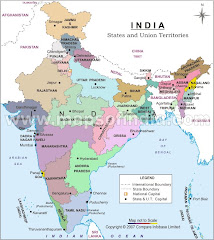Regarding the rapidly growth of the population and the economic development, India goes to an environmental degradation.
Indeed, having the 18% of the world’s population on the 2.4% world’s area, India has greatly wasted its natural resources: water and air pollution, deforestation, water shortages, soil exhaustion…
However, India is riding high on outsourcing. Information technology and IT-enabled services will employ 4 million people in 2008 and account for 7% of gross domestic product and 33% of India's foreign-exchange inflows, according to Nasscom, an Indian IT industry organization.
The reality is that wages are rising in India. The cost advantage for offshoring to India used to be at least 1:6. Today, it is at best 1:3. Attrition is scary. Jobs that are low value-added and easily automatable should and will disappear over the next decade.
People talk a lot about India moving up the value chain. Some of that has indeed happened. An industry that started gaining momentum when Indian software developers were tapped to help fix the "Y2K" problems in old software code has blossomed beautifully into one that offers a much more comprehensive spectrum of services.
INDIA’S ECONOMIC INDICATORS
The boom in India Inc's is attributed to steep rise of key India Economic Indicators like Industrial Growth, FIIs and FDIs. Further, other India Economic Indicators like Balance-of-Payments, Merchandise Exports, Invisible Accounts and Foreign-Exchange-Reserves also had substantial contribution toward growth of Indian Economy.
India's Industrial Growth - for the first time has exceeded 10%. Manufacturing growth rate has exceeded 12 % in 6 months. The mining and quarrying sector has registered a growth of 4%. The electricity sector recorded a double-digit growth of 12% during September 2006 as compared to September 2005. Consumer durables and non-durables have also recorded upswings. The use-base economic sub-groups, intermediate goods have registered an impressive growth of almost 15% during September 2006 over September 2005. Consumer goods have recorded a high growth of 13%. The National Manufacturing Competitiveness Council has targeted 12 to 14% growth in the 11th Plan period.
Net investments in equities crossed US$ 7 billion in calendar 2006. FII net investment till November 2006 has been US$ 7.08 billion, according to the Securities and Exchange Board of India. 151 new FIIs have opened their offices in India during first 10 months of 2006. The total number of FIIs in India stands at 974 as on November 2006.
FDI - India envisage of attracting $10 billion of foreign direct investment (FDI) this year as inflows have nearly doubled to US$ 4.4 billion in April-September 2006. In September 2006, FDI inflows grew 225% to US$ 916 million as compared to US$ 282 million in the same month last year. Services attracted maximum investment of US$ 1.5 billion recording growth of 350%. Telecom sector with inflows of US$ 405 million has registered the maximum growth of 950%. Corporate India has recorded its highest rise in salaries at 22% in the first half of 2006-07 against increase of 17% in 2005-06.
Merchandise Exports - recorded strong growth.
The Invisibles Account remained positive during last financial year and financed 2/3 of the trade deficit.
India's Foreign Exchange Reserves - were US$ 166.2 billion as on October 2006, showing increment of US$ 14.5 billion over end-March 2006.
The upswing in ' Indicators of Indian Economy ' especially manufacturing and services sector activities together with bullish stock market suggests that the recent growth momentum of the India Economic Indicators is likely to be maintained further.
INDIA’S OUTSOURCING WORKERS
The outsourcing revolution has legions of alarmed office workers terrified of losing their jobs in the west. Far too many of India’s youth are being sucked into a work culture that promises one thing and delivers quite another. Indeed, behind the promise of a good salary (about US$800 per month, India’s average salary for a whole year), outsourcing jobs involve gruelling work schedules straddling multifarious time zones and cultures, tight deadlines, ambitious targets, phones that never stop ringing and rude and demanding callers.
Cumulatively, this is spiraling into a burnout phenomenon for many of India’s 7 million-plus outsourcing workers. The industry calls it BOSS -- Burn Out Stress Syndrome. According to doctors, BOSS affects a third of call centre workers with symptoms that include chronic fatigue, insomnia, alteration of biorhythms, loss of appetite, gastrointestinal problems and others. Physical problems like back pain and shoulder pain are also common and -- with excessive exposure to computers, headphones and other such equipment -- many ear and eye-related ailments.
The government, in the meantime, is being asked to urgently announce a promised new health policy for outsourcing workers as a prerequisite for worker satisfaction and productivity to restore the sheen to India’s `sunshine’ industry. Till then, dark clouds loom over its workers’ health.
While similarities in business culture and language will keep India at the top of the United Kingdom's list of outsourcing hot spots, Eastern Europe and Russia could be set to emerge as an alternative.



